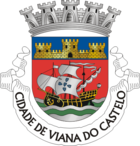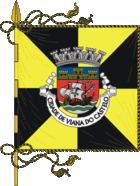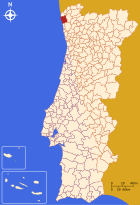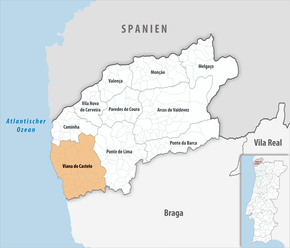Viana do Castelo
| Viana do Castelo | ||||||
|---|---|---|---|---|---|---|
|
||||||
| Basic data | ||||||
| Region : | Norte | |||||
| Sub-region : | Alto Minho | |||||
| District : | Viana do Castelo | |||||
| Concelho : | Viana do Castelo | |||||
| Coordinates : | 41 ° 42 ′ N , 8 ° 50 ′ W | |||||
| Residents: | 88,725 (as of June 30, 2011) | |||||
| Surface: | 319.02 km² (as of January 1, 2010) | |||||
| Population density : | 278 inhabitants per km² | |||||
| Height: | 15 m | |||||
| Viana do Castelo county | ||||||
|
||||||
| Residents: | 88,725 (as of June 30, 2011) | |||||
| Surface: | 319.02 km² (as of January 1, 2010) | |||||
| Population density : | 278 inhabitants per km² | |||||
| Number of municipalities : | 27 | |||||
| administration | ||||||
| Administration address: | Câmara Municipal de Viana do Castelo Passeio das Mordomas da Romaria 4904-877 Viana do Castelo |
|||||
| Website: | www.cm-viana-castelo.pt | |||||
Viana do Castelo is a city in Portugal and the capital of the district and county of the same name in the Northern Region of Portugal. It is located north of the hose-like mouth of the Rio Lima into the Atlantic .
The place
history
The Iron Age settlement Citânia de Santa Luzia is nearby.
Viana do Castelo was called "Viana da Foz do Lima" ("Viana at the mouth of the Lima River") in 1258 by Alfonso III. (1248–1279) founded. The city soon came to great wealth, which attracted both Spaniards and pirates. Thereupon was still under Alfons III. built the first fortress at the mouth of the Lima that dominated the estuary. The oldest known date results from the XV. Century, when a fortress was built in the southern part of the old bastion under Dom Manuel I , the "Torre da Roqueta". End of the XV. In the 19th century, renovation work became necessary, which was carried out by the then very well-known military building architect , Filippo Terzi , under the Spanish rule of Philip II (Philip I of Portugal). Viana do Castelo received its town charter in 1848 from the Portuguese Queen Maria II .
Attractions
One of the most picturesque medieval squares in Portugal is the Praça da República, which goes back to the art-loving Dom Manuel I. The three-shell Renaissance fountain (1553–1559) by João Lopez-o-Velho is particularly noteworthy . It was copied many times, for example. B. a few years later for the city of Caminha on the south bank of the Rio Minho , on the Portuguese-Spanish border, or in other cities, e.g. B. in Pontevedra in Galicia . For several centuries the fountain not only served as the only source of drinking water, but thanks to its location in front of the old town hall (Paço do Concelho) it was also the meeting point and social center of the city.
The Museu Municipal in Viana do Castelo houses the statue of a warrior from São Paio de Meixedo, (also known as the ' Estátua de Viana ' or 'do Páteo da Morte'), one of the three pieces that Emil Hübner presented in 1861 when he was in northern Portugal the resulting statues of Gaulish warriors . In the museum it is now shown as a sculpture of a warrior of the Castro culture (Escultura de um guerreiro castrejo) with a Latin inscription from the 1st century AD.
The museum ship Gil Eannes is located in the port of the city - a hospital ship built in 1955 that was used until 1973 to support the Portuguese cod fishermen in the North Atlantic .
Town twinning
Viana do Castelo maintains partnerships with numerous cities and municipalities.
The relationships according to are particularly numerous
-
 Brazil
Brazil
- Cabedelo , Paraíba State , since 2003
- Igarassu State of Pernambuco , since 2003
- Porto Seguro State of Bahia , since 1997
- Itajaí , Santa Catarina State , since 1995
- Viana , Maranhão State
Further partnerships exist with
-
 Hendaye in the Nouvelle-Aquitaine region (France), since 1998
Hendaye in the Nouvelle-Aquitaine region (France), since 1998 -
 Lugo in Galicia (Spain), since 1990
Lugo in Galicia (Spain), since 1990 -
 Lancaster in the county of Lancashire (Great Britain), since 1989
Lancaster in the county of Lancashire (Great Britain), since 1989 -
 Ziguinchor in Senegal , since 1989
Ziguinchor in Senegal , since 1989 -
 Cacheu (city) in Guinea-Bissau , since 1988
Cacheu (city) in Guinea-Bissau , since 1988 -
 Riom in the Auvergne-Rhône-Alpes region (France), since 1982
Riom in the Auvergne-Rhône-Alpes region (France), since 1982 -
 Aveiro in Portugal , since 1910
Aveiro in Portugal , since 1910 -
 Matola in Mozambique , since 2006
Matola in Mozambique , since 2006
Partnership relationships also exist with
-
 the state of Alagoas in Brazil, since 2006
the state of Alagoas in Brazil, since 2006 -
 the United Parishes of the Island of Santo Antão in Cape Verde
the United Parishes of the Island of Santo Antão in Cape Verde
-
 Pessac in the Nouvelle-Aquitaine region (France), since 2010
Pessac in the Nouvelle-Aquitaine region (France), since 2010
sons and daughters of the town
- Caramuru (Diogo Álvares Correia, 1475–1557), colonist in Brazil, important liaison with the indigenous people
- Raimundo Enes Meira (1866–1946), officer, colonial administrator and politician
- Cláudio Filipe de Oliveira Basto (1886–1945), ethnographer, Romanist , Lusitanist and dialectologist
- Aníbal do Paço Quesado (1931–2011), archaeologist, worked mainly in Germany
- Defensor Moura (* 1945), doctor and socialist politician
- Pio Gonçalo Alves de Sousa (* 1945 in Lanheses), auxiliary bishop in Porto
- João Manuel da Cruz da Silva Leitão (* 1952), diplomat
- Maria Manuela Machado (* 1963), long-distance runner
- Rui Lavarinhas (* 1971), racing cyclist
- Rui Sousa (* 1976), racing cyclist
- Tiago (* 1981), soccer player
- André Moreira (* 1982), racing cyclist
- Luís Lourenço (* 1984), actor
- Mário Costa (* 1986), jazz musician
- Mário Felgueiras (* 1986), football player
- João Queirós (* 1998), football player
- Iúri Leitão (* 1998), cyclist
- Francisco Trincão (* 1999), football player
- Pedro Neto (* 2000), soccer player
gallery
- Pictures from Viana do Castelo
The circle
administration
Viana do Castelo is the seat of a district of the same name. The neighboring areas are (starting clockwise from the north): Caminha , Ponte de Lima , Barcelos and Esposende . In the west, the Atlantic Ocean delimits the municipality.
With the regional reform in September 2013 , several municipalities were merged to form new municipalities, so that the number of municipalities decreased from 40 to 28.
The following municipalities ( freguesias ) are in the county of Viana do Castelo:
| local community | Population (2011) |
Area km² |
Density of population / km² |
LAU code |
|---|---|---|---|---|
| Afife | 1,632 | 13.03 | 125 | 160901 |
| Alvarães | 2,623 | 9.11 | 288 | 160902 |
| Amonde | 293 | 6.25 | 47 | 160903 |
| Areosa | 4,853 | 14.11 | 344 | 160905 |
| Barroselas e Carvoeiro | 5,031 | 18.68 | 269 | 160941 |
| Cardielos e Serreleis | 2,312 | 7.68 | 301 | 160942 |
| Carreço | 1,759 | 14.20 | 124 | 160908 |
| Castelo do Neiva | 2,930 | 6.94 | 422 | 160910 |
| Chafé | 2,841 | 7.85 | 362 | 160940 |
| Darque | 7,817 | 9.01 | 867 | 160911 |
| Freixieiro de Soutelo | 511 | 11.78 | 43 | 160914 |
| Geraz do Lima e Deão | 3,339 | 19.06 | 175 | 160943 |
| Lanheses | 1,645 | 9.60 | 171 | 160915 |
| Mazarefes e Vila Fria | 2,670 | 10.28 | 260 | 160944 |
| Montaria | 549 | 22.43 | 24 | 160920 |
| Mujães | 1,550 | 4.90 | 316 | 160922 |
| Neiva | 1,225 | 7.02 | 174 | 160923 |
| Nogueira, Meixedo e Vilar de Murteda | 1,597 | 27.41 | 58 | 160945 |
| Outeiro | 1,234 | 18.83 | 66 | 160925 |
| Lock | 2,956 | 13.09 | 226 | 160926 |
| Santa Marta de Portuzelo | 3,805 | 7.41 | 513 | 160928 |
| Subportela, Deocriste e Portela Susã | 2,552 | 17.10 | 149 | 160946 |
| Torre e Vila Mou | 1,181 | 6.35 | 186 | 160947 |
| Viana do Castelo e Meadela | 25,375 | 14.32 | 1,771 | 160948 |
| Vila de Punhe | 2,273 | 6.03 | 377 | 160938 |
| Vila Franca | 1,757 | 7.15 | 246 | 160935 |
| Vila Nova de Anha | 2,415 | 9.40 | 257 | 160904 |
| Viana do Castelo county | 88,725 | 319.02 | 278 | 1609 |
Population development
| year | 1801 | 1849 | 1900 | 1930 | 1960 | 1981 | 1991 | 2001 | 2004 |
| Residents | 17,889 | 36,084 | 47,311 | 53,380 | 75,320 | 81.009 | 83,095 | 88,631 | 90,654 |
Abolition of bullfights
In 2009, Viana do Castelo was the first Portuguese municipality to abolish bullfighting on the grounds of cruelty to animals. On August 19, 2012, the city of Areosa, part of Viana do Castelo, was forced by the court to host a bullfighting event, although the local council tried to prevent it. Defense attorney Moura, mayor at the time the bullfighting ban was approved, criticized the court for making a "scandalous decision".
literature
- Thomas G. Schattner (Ed.): Archaeological guide through Portugal (= cultural history of the ancient world . Vol. 74). Philipp von Zabern, Mainz 1998, ISBN 3-8053-2313-1 p. 59
Web links
City page on cm-viana-castelo.pt
swell
- ↑ a b www.ine.pt - indicator resident population by place of residence and sex; Decennial in the database of the Instituto Nacional de Estatística
- ↑ a b Overview of code assignments from Freguesias on epp.eurostat.ec.europa.eu
- ^ Emil Huebner: Statues of Gallaean warriors in Portugal and Galicia . In: Archäologische Zeitung , Vol. 19 (1861), No. 154, Col. 185–195.
- ↑ Source: Viana do Castelo website
- ^ Publication of the administrative reorganization in the Diário da República gazette of January 28, 2013, accessed on March 16, 2014
- ^ [1] Sell-out bullfight held in Viana do Castelo against council's will
| ← Previous location: Póvoa de Varzim |
|
Next town: Caminha → |



















